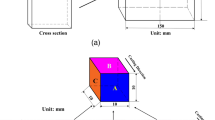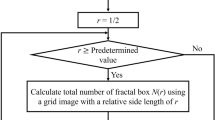Abstract
Solidification structure, as solid skeleton, determines directly the properties of materials, and segregation defects (i.e., uneven distribution of alloy elements) are also affected by the morphology of solidification structure. The high-carbon steel is one of the typical high-end steels, and its solidification morphology is always more complicated and segregation defects are more serious. In this study, solidification morphology of high-carbon steel with 0.82 wt% carbon content in continuously cast was investigated based on fractal theory in order to evaluate solidification characteristics of the liquid steel and control the segregation defects. It was demonstrated that the fractal dimension calculated via the box count method is effective to characterize quantitatively the complexity of the overall morphology of solidification structure instead of only local features. Further, a positive linear correlation (fitting coefficients R2 > 0.95) between fractal dimension and solidification structure ratio (Rstr) was found, i.e., the fractal dimension increases with increasing Rstr. The phenomenon of dendrite morphology complexity, which increases with increasing Rstr, is called the increasingly complicated dendrite overall morphology. It can be attributed to the increasing constitutional undercooling. In addition, the entropy in solidification system calculated by fractal dimension increases gradually in direction from the outer to middle zones of the billet. This indicates that the chaos of the solidifying interface increases gradually, which contributes to the understanding the solidification process. This study proposed a new parameter that depicts the overall solidification morphology from self-similar perspective, thus providing guidance for us to control the solidification morphology and segregation defects delicately.











Similar content being viewed by others
References
Flemings MC, Shiohara Y (1984) Solidification of undercooled metals. Mater Sci Eng 65:157–170
Flemings MC (2000) Our understanding of macrosegregation: past and present. ISIJ Int 40:838–841
Pickering EJ (2013) Macrosegregation in steel ingots: the applicability of modelling and characterisation techniques. ISIJ Int 53:935–949
Choudhary SK, Ganguly S, Sengupta A, Sharma V (2017) Solidification morphology and segregation in continuously cast steel slab. J Mater Process Technol 243:312–321
Zhong XT, Rowenhorst DJ, Beladi H, Rohrer GS (2017) The five-parameter grain boundary curvature distribution in an austenitic and ferritic steel. Acta Mater 123:136–145
Harada H, Miyazawa K, Matsumiya T, Morohoshi T, Esaka H (2009) Numerical prediction of solidification structure taking account of molten steel flow. Tetsu-to-Hagané 89:265–272
Mandelbrot BB (1982) The Fractal Geometry of Nature, 1st edn. Freeman Press, New York, pp 131–135
Mandelbrot BB (1967) How long is the Coast of Britain? Statistical Self-similarity and fractional dimension. Science 155:636–638
Zhou GY, Leu MC, Blackmore D (1993) Fractal geometry model for wear prediction. Wear 170:1–14
West GB, Brown JH, Enquist BJ (1999) The fourth dimension of life: fractal geometry and allometric scaling of organisms. Science 284:1677–1679
Yu BM, Cheng P (2002) A fractal permeability model for bi-dispersed porous media. Int J Heat Mass Transf 45:2983–2993
Rozwadowski M, Kornatowski J, Włoch J, Erdmann K, Gołembiewski R (2002) Attempt to apply the fractal geometry for characterisation of dealuminated ZSM-5 zeolite. Appl Surf Sci 191:352–361
Sanyal D, Ramachandrarao P, Gupta OP (2006) A fractal description of transport phenomena in dendritic porous network. Chem Eng Sci 61:307–315
Mandelbrot BB, Passoja DE, Paullay AJ (1984) Fractal character of fracture surfaces of metals. Nature 308:721–722
Tanaka M (1992) Characterization of grain-boundary configuration and fracture surface roughness by fractal geometry and creep-rupture properties of metallic materials. J Mater Sci 27:4717–4725. https://doi.org/10.1007/BF01166012
Tanaka M (1996) Fractal dimension of the grain boundary fracture in creep-fracture of cobalt-based heat resistant alloys. J Mater Sci 31:3513–3521. https://doi.org/10.1007/BF00360757
Yang A, Xiong Y, Liu L (2001) Fractal characteristics of dendrite and cellular structure in nickel-based superalloy at intermediate cooling rate. Sci Technol Adv Mater 2:101–103
Ishida H, Natsume Y, Ohsasa K (2009) Characterization of dendrite morphology for evaluating interdendritic fluidity based on phase-field simulation. ISIJ Int 49:37–43
Hou ZB, Cheng GG, Wu CC, Chen C (2012) Time-series analysis technologies applied to the study of carbon element distribution along casting direction in continuous-casting billet. Metall Mater Trans B 43:1517–1529
Hou ZB, Cao JH, Chang Y, Wang W, Chen H (2017) Morphology characteristics of carbon segregation in die steel billet by ESR based on fractal dimension. Acta Metall Sin 53:769–777
Yamamoto M, Narita I, Miyahara H (2013) Fractal analysis of solidification microstructure of high carbon high alloy cast roll manufactured by centrifugal casting. Tetsu-to-Hagané 99:72–79
Bowe TF, Brody HD, Flemings MC (1996) Measurement of solute redistribution in dendritic solidification. Trans Metall Soc AIME 236:624–634
Beckermann C (2002) Modelling of macrosegregation: applications and future needs. Int Mater Rev 47:243–261
Burton JA, Prim RC, Slichter WP (1953) The distribution of solute in crystals grown from the melt. Part I. theoretical. J Chem Phys 21:1987–1991
Hou ZB, Guo DW, Cao JH, Chang Y (2018) A method based on the centroid of segregation points: a Voronoi polygon application to solidification of alloys. J Alloy Compd 762:508–519
Tiller WA, Jackson KA, Rutter JW, Chalmers B (1953) The redistribution of solute atoms during the solidification of metals. Acta Metall 1:428–437
Hou ZB, Jiang F, Cheng GG (2012) Solidification structure and compactness degree of central equiaxed grain zone in continuous casting billet using cellular automaton-finite element method. ISIJ Int 52:1301–1309
Eiichi A, Hisao E, Kei S (2016) Mechanism for complex morphology due to mechanical vibration. ISIJ Int 56:1413–1419
Won YM, Thomas BG (2001) Simple model of microsegregation during solidification of steels. Metall Mater Trans A 32:1755–1767
Chakraborty S, Dutta P (2001) Effects of dendritic arm coarsening on macroscopic modelling of solidification of binary alloys. Mater Sci Technol 17:1531–1538
Chen M, Kattamis TZ (1998) Dendrite coarsening during directional solidification of Al–Cu–Mn alloys. Mater Sci Eng, A 247:239–247
Marsh SP, Glicksman ME (1996) Overview of geometric effects on coarsening of mushy zones. Mater Sci Eng, A 27:557–567
Langer JS (1980) Instabilities and pattern formation in crystal growth. Rev Mod Phys 52:1–28
Li RS (1984) Non-equilibrium thermodynamics and dissipative structure, 1st edn. Tsinghua University Press, Beijing
Grassberger P (1983) Generalized dimensions of strange attractors. Phys Lett A 97:227–230
Acknowledgement
The authors are very grateful for support from United Funds between National Natural Science Foundation and Baowu Steel Group Corporation Limited from China (No. U1860101) and Chongqing Fundamental Research and Cutting-Edge Technology Funds (No. cstc2017jcyjAX0019). The authors thank the companies for providing Image-Pro Plus ® 6.0 Software.
Author information
Authors and Affiliations
Corresponding author
Ethics declarations
Conflict of interest
All authors declare that they have no conflict of interest.
Additional information
Publisher's Note
Springer Nature remains neutral with regard to jurisdictional claims in published maps and institutional affiliations.
Rights and permissions
About this article
Cite this article
Cao, J., Hou, Z., Guo, D. et al. Morphology characteristics of solidification structure in high-carbon steel billet based on fractal theory. J Mater Sci 54, 12851–12862 (2019). https://doi.org/10.1007/s10853-019-03782-4
Received:
Accepted:
Published:
Issue Date:
DOI: https://doi.org/10.1007/s10853-019-03782-4




